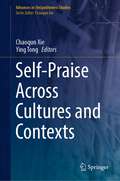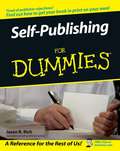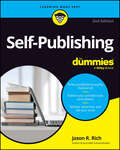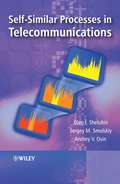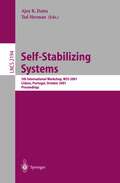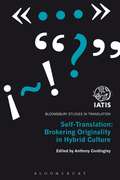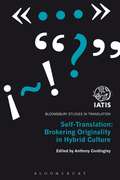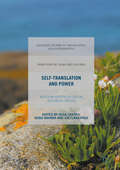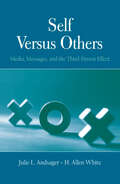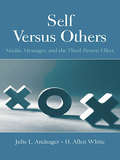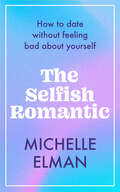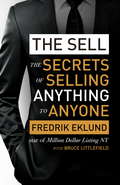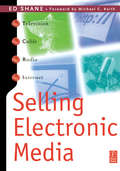- Table View
- List View
Self-Organizing Maps (Springer Series in Information Sciences #30)
by Teuvo KohonenThe Self-Organizing Map (SOM), with its variants, is the most popular artificial neural network algorithm in the unsupervised learning category. About 4000 research articles on it have appeared in the open literature, and many industrial projects use the SOM as a tool for solving hard real world problems. Many fields of science have adopted the SOM as a standard analytical tool: statistics, signal processing, control theory, financial analyses, experimental physics, chemistry and medicine. This new edition includes a survey of over 2000 contemporary studies to cover the newest results. Case examples are provided with detailed formulae, illustrations, and tables. Further, a new chapter on software tools for SOM has been included whilst other chapters have been extended and reorganised.
Self-Organizing Networks: Self-Planning, Self-Optimization and Self-Healing for GSM, UMTS and LTE
by Juan Ramiro Khalid HamiedWith the current explosion in network traffic, and mounting pressure on operators’ business case, Self-Organizing Networks (SON) play a crucial role. They are conceived to minimize human intervention in engineering processes and at the same time improve system performance to maximize Return-on-Investment (ROI) and secure customer loyalty. Written by leading experts in the planning and optimization of Multi-Technology and Multi-Vendor wireless networks, this book describes the architecture of Multi-Technology SON for GSM, UMTS and LTE, along with the enabling technologies for SON planning, optimization and healing. This is presented mainly from a technology point of view, but also covers some critical business aspects, such as the ROI of the proposed SON functionalities and Use Cases. Key features: Follows a truly Multi-Technology approach: covering not only LTE, but also GSM and UMTS, including architectural considerations of deploying SON in today’s GSM and UMTS networks Features detailed discussions about the relevant trade-offs in each Use Case Includes field results of today’s GSM and UMTS SON implementations in live networks Addresses the calculation of ROI for Multi-Technology SON, contributing to a more complete and strategic view of the SON paradigm This book will appeal to network planners, optimization engineers, technical/strategy managers with operators and R&D/system engineers at infrastructure and software vendors. It will also be a useful resource for postgraduate students and researchers in automated wireless network planning and optimization.
Self-Organizing Networks: Self-Planning, Self-Optimization and Self-Healing for GSM, UMTS and LTE
by Juan Ramiro Khalid HamiedWith the current explosion in network traffic, and mounting pressure on operators’ business case, Self-Organizing Networks (SON) play a crucial role. They are conceived to minimize human intervention in engineering processes and at the same time improve system performance to maximize Return-on-Investment (ROI) and secure customer loyalty. Written by leading experts in the planning and optimization of Multi-Technology and Multi-Vendor wireless networks, this book describes the architecture of Multi-Technology SON for GSM, UMTS and LTE, along with the enabling technologies for SON planning, optimization and healing. This is presented mainly from a technology point of view, but also covers some critical business aspects, such as the ROI of the proposed SON functionalities and Use Cases. Key features: Follows a truly Multi-Technology approach: covering not only LTE, but also GSM and UMTS, including architectural considerations of deploying SON in today’s GSM and UMTS networks Features detailed discussions about the relevant trade-offs in each Use Case Includes field results of today’s GSM and UMTS SON implementations in live networks Addresses the calculation of ROI for Multi-Technology SON, contributing to a more complete and strategic view of the SON paradigm This book will appeal to network planners, optimization engineers, technical/strategy managers with operators and R&D/system engineers at infrastructure and software vendors. It will also be a useful resource for postgraduate students and researchers in automated wireless network planning and optimization.
Self-Organizing Systems: 5th International Workshop, IWSOS 2011, Karlsruhe, Germany, February 23-24, 2011, Proceedings (Lecture Notes in Computer Science #6557)
by Christian Bettstetter Carlos GershensonThis book constitutes the refereed proceedings of the 5th International Workshop on Self-Organizing Systems, IWSOS 2011, held in Karlsruhe, Germany, in February 2011. The 9 revised full papers presented together with 1 invited paper were carefully selected from 25 initial submissions. It was the 5th workshop in a series of multidisciplinary events dedicated to self-organization in networked systems with main focus on communication and computer networks. The papers address theoretical aspects of self-organization as well as applications in communication and computer networks and robot networks.
Self-Organizing Systems: 7th IFIP TC6 International Workshop, IWSOS 2013, Palma de Mallorca, Spain, May 9-10, 2013, Revised Selected Papers (Lecture Notes in Computer Science #8221)
by Wilfried Elmenreich Falko Dressler Vittorio LoretoThis book constitutes the thoroughly refereed post-conference proceedings of the 7th IFIP TC 6 International Workshop on Self-Organizing Systems, IWSOS 2013, held in Palma de Mallorca, Spain, in May 2013. The 11 revised full papers and 9 short papers presented were carefully selected from 35 paper submissions. The papers are organized in following topics: design and analysis of self-organizing and self-managing systems, inspiring models of self-organization in nature and society, structure, characteristics and dynamics of self-organizing networks, self-organization in techno-social systems, self-organized social computation and self-organized communication systems.
Self-Organizing Systems: Third International Workshop, IWSOS 2008, Vienna, Austria, December 10-12, 2008 (Lecture Notes in Computer Science #5343)
by Karin Anna Hummel James P. G. SterbenzThis book constitutes the refereed proceedings of the Third International Workshop on Self-Organizing Systems, IWSOS 2008, held in Vienna, Austria, December 10-12, 2008. The 20 revised full papers and 13 revised short papers presented were carefully selected from the 70 full and 24 short paper submissions from authors from 33 different countries. The papers are organized in topical sections on peer-to-peer systems, overlay networks as well as resource and service management.
Self-Organizing Systems: Second International Workshop, IWSOS 2007, The Lake District, UK, September 11-13, 2007, Proceedings (Lecture Notes in Computer Science #4725)
by David Hutchison Randy H. KatzThis book constitutes the refereed proceedings of the Second International Workshop on Self-Organizing Systems, IWSOS 2007. The 17 revised full papers and five revised short papers presented together with two invited talks were carefully selected from more than 36 submissions. The papers are organized in topical sections on ad hoc routing, peer-to-peer networking, network topology, adaptive and self-organizing networks and multicast and mobility protocols.
Self-Organizing Systems: 6th IFIP TC 6 International Workshop, IWSOS 2012, Delft, The Netherlands, March 15-16, 2012, Proceedings (Lecture Notes in Computer Science #7166)
by Fernando A. Kuipers Poul E. HeegaardThis book constitutes the refereed proceedings of the 6th IFIP TC 6 International Workshop on Self-Organizing Systems, IWSOS 2012, held in Delft, The Netherlands, in March 2012. The 5 revised full papers and 5 short papers presented together with 2 invited papers were carefully selected from 25 full paper and 8 short paper submissions. The papers address the following key topics: design and analysis of self-organizing and self-managing systems; inspiring models of self-organization in nature and society; structure, characteristics and dynamics of self-organizing networks; techniques and tools for modeling self-organizing systems; robustness and adaptation in self-organizing systems; self-organization in complex networks like peer-to-peer, sensor, ad-hoc, vehicular and social networks; control of self-organizing systems; decentralized power management in the smart grid; self-organizing group and pattern formation; self-organizing mechanisms for task allocation, coordination and resource allocation; self-organizing information dissemination and content search; and risks and limits of self-organization.
Self-Powered Internet of Things: How Energy Harvesters Can Enable Energy-Positive Sensing, Processing, and Communication (Green Energy and Technology)
by Muhammad Moid Sandhu Sara Khalifa Marius Portmann Raja JurdakThis book covers cutting edge advancements on self-powered Internet of Things, where sensing devices can be energy-positive while capturing context from the physical world. It provides new mechanisms for activity recognition without the need of conventional inertial sensors, which demand significant energy during their operation and thus quickly deplete the batteries of internet-of-things (IoT) devices. The book offers new solutions by employing energy harvesters as activity sensors as well as power sources to enable the autonomous and self-powered operation of IoT devices without the need of human intervention. It provides useful content for graduate students as well as researchers to understand the nascent technologies of human activity, fitness and health monitoring using autonomous sensors. In particular, this book is very useful for people working on pervasive computing, activity recognition, wearable IoT, fitness/healthcare and autonomous systems.This book covers a broad range of topics related to self-powered activity recognition. The main topics of this book include wearables, IoT, energy harvesting, energy harvesters as sensors, activity recognition and self-powered operation of IoT devices. This book starts with the introduction of wearable IoT devices and activity recognition and then highlights the conventional activity recognition mechanisms. After that, it describes the use of energy harvesters to power the IoT devices. Later, it explores the use of various energy harvesters as activity sensors. It also proposes the use of energy harvesters as simultaneous source of energy and context information and defines the emerging concept of energy-positive sensing compared to conventional energy-negative sensing. Finally, it explores sensor/signal fusion to enhance the performance using multiple energy harvesters and charts a way forward for future research in this area. This book covers all important and emerging topics that have significance in the design and implementation of autonomous wearable IoT devices. We believe that this book will lay the foundation for designing self-powered IoT devices which can ultimately replace the conventional wearable IoT devices which need regular recharging and replacement.
Self-Praise Across Cultures and Contexts (Advances in (Im)politeness Studies)
by Chaoqun Xie Ying TongThis book explores the extent to which self-praise is acceptable in both offline and online contexts, across different genres, platforms, and cultural backgrounds. The data analyzed encompass both naturally occurring (daily conversation as well as institutional talk) and elicited (experiments and interviews) types, and are explored at both quantitative and qualitative levels to offer a relatively systematic and comprehensive inquiry into self-praise as social (inter)action. Contributors to this book not only draw on traditional politeness theories but are also informed by social psychology, interactional sociolinguistics, CMC, and (multimodal) discourse analysis. They are inspired by pragmatics but also go beyond to ground their studies within locally situated cultural contexts, most of which are under-presented in the current academic world. Their efforts substantiate the fact that self-praise is most worthy of intensive analytic attention. This book appeals to students and researchers in the field and contributes to the way communication is facilitated through different ways of deploying linguistic and interactional resources.
Self-Publishing For Dummies (For Dummies Ser.)
by Jason R. RichCovers budgeting, copyrighting, and marketing Know the pros and cons of self-publishing and get your work in print Thinking about self-publishing your book? This no-nonsense guide walks you through the entire process of going it alone, from preparing your manuscript and creating the perfect title to selling the final product. You'll see how to obtain an ISBN, work with printers and distributors, create a buzz with publicity, and take advantage of electronic publishing. Discover how to * Start your own publishing company * Edit your work effectively * Design and format your book * Hire skilled professionals to help * Manage outside vendors * Build awareness for your book online
Self-Publishing For Dummies
by Jason R. RichCovers budgeting, copyrighting, and marketing Know the pros and cons of self-publishing and get your work in print Thinking about self-publishing your book? This no-nonsense guide walks you through the entire process of going it alone, from preparing your manuscript and creating the perfect title to selling the final product. You'll see how to obtain an ISBN, work with printers and distributors, create a buzz with publicity, and take advantage of electronic publishing. Discover how to * Start your own publishing company * Edit your work effectively * Design and format your book * Hire skilled professionals to help * Manage outside vendors * Build awareness for your book online
Self-Publishing For Dummies
by Jason R. RichGet your books into the hands of readers with this simple how-to guide Self-Publishing For Dummies takes you through the entire process of publishing your own books, starting with the writing and editing process and moving through cover design, printing options, distribution channels, and marketing to a target audience. With the advice in this book, you can tackle self-publishing, no matter what genre you write in. You’ll learn how to retain full control over your work and keep the profits from the sales of your book. In this updated edition, you’ll discover the latest technologies in self-publishing, trends in the world of ebooks, and new marketing techniques you can use online and in the real world. Becoming a published author is easier than ever, thanks to this Dummies guide. Understand every step in the self-publishing process Discover how to write and sell your books in ebook and printed formats Hire an editor, obtain an ISBN, and generate publicity for your book Fine-tune your writing to improve your chances of success Get your work out there—no agent or publisher neededSelf-Publishing For Dummies is the perfect choice for anyone with an interest in DIY publishing.
Self-Publishing For Dummies
by Jason R. RichGet your books into the hands of readers with this simple how-to guide Self-Publishing For Dummies takes you through the entire process of publishing your own books, starting with the writing and editing process and moving through cover design, printing options, distribution channels, and marketing to a target audience. With the advice in this book, you can tackle self-publishing, no matter what genre you write in. You’ll learn how to retain full control over your work and keep the profits from the sales of your book. In this updated edition, you’ll discover the latest technologies in self-publishing, trends in the world of ebooks, and new marketing techniques you can use online and in the real world. Becoming a published author is easier than ever, thanks to this Dummies guide. Understand every step in the self-publishing process Discover how to write and sell your books in ebook and printed formats Hire an editor, obtain an ISBN, and generate publicity for your book Fine-tune your writing to improve your chances of success Get your work out there—no agent or publisher neededSelf-Publishing For Dummies is the perfect choice for anyone with an interest in DIY publishing.
Self-Similar Processes in Telecommunications
by Oleg Sheluhin Sergey Smolskiy Andrew OsinFor the first time the problems of voice services self-similarity are discussed systematically and in detail with specific examples and illustrations. Self-Similar Processes in Telecommunications considers the self-similar (fractal and multifractal) models of telecommunication traffic and efficiency based on the assumption that its traffic has fractal or multifractal properties (is self-similar). The theoretical aspects of the most well-known traffic models demonstrating self-similar properties are discussed in detail and the comparative analysis of the different models’ efficiency for self-similar traffic is presented. This book demonstrates how to use self-similar processes for designing new telecommunications systems and optimizing existing networks so as to achieve maximum efficiency and serviceability. The approach is rooted in theory, describing the algorithms (the logical arithmetical or computational procedures that define how a task is performed) for modeling these self-similar processes. However, the language and ideas are essentially accessible for those who have a general knowledge of the subject area and the advice is highly practical: all models, problems and solutions are illustrated throughout using numerous real-world examples. Adopts a detailed, theoretical, yet broad-based and practical mathematical approach for designing and operating numerous types of telecommunications systems and networks so as to achieve maximum efficiency Places the subject in context, describing the current algorithms that make up the fractal or self-similar processes while pointing to the future development of the technology Offers a comparative analysis of the different types of self-similar process usage within the context of local area networks, wide area networks and in the modeling of video traffic and mobile communications networks Describes how mathematical models are used as a basis for building numerous types of network, including voice, audio, data, video, multimedia services and IP (Internet Protocol) telephony The book will appeal to the wide range of specialists dealing with the design and exploitation of telecommunication systems. It will be useful for the post-graduate students, lecturers and researchers connected with communication networks disciplines.
Self-Stabilizing Systems: 5th International Workshop, WSS 2001, Lisbon, Portugal, October 1-2, 2001 Proceedings (Lecture Notes in Computer Science #2194)
by Ajoy K. Datta Ted HermanPhysicalsystemswhichrightthemselvesafterbeingdisturbedevokeourcuriosity becausewe wantto understand howsuchsystemsareableto reactto unexpected stimuli. Themechanismsareallthe morefascinatingwhensystemsarecomposed of small, simple units, and the ability of the system to self-stabilize emerges out of its components. Faithful computer simulations of such physical systems exhibit the self-stabilizing property, but in the realm of computing, particularly for distributed systems, wehavegreaterambition. We imaginethat all manner of software, ranging from basic communication protocols to high-level applications, could enjoy self-corrective properties. Self-stabilizing software o?ers a unique, non-traditional approach to the c- cial problem of transient fault tolerance. Many successful instances of modern fault-tolerant networks are based on principles of self-stabilization. Surprisingly, the most widely accepted technical de?nition of a self-stabilizing system does not refer to faults: it is the property that the system can be started in any i- tial state, possibly an “illegal state,” and yet the system guarantees to behave properly in ?nite time. This, and similar de?nitions, break many traditional approaches to program design, in which the programmer by habit makes - sumptions about initial conditions. The composition of self-stabilizing systems, initially seen as a daunting challenge, has been transformed into a mana- able task, thanks to an accumulation of discoveries by many investigators. - search on various topics in self-stabilization continues to supply new methods for constructing self-stabilizing systems, determines limits and applicability of the paradigm of self-stabilization, and connects self-stabilization to related areas of fault tolerance and distributed computing.
Self-Translation: Brokering Originality in Hybrid Culture (Bloomsbury Studies in Translation)
by Anthony CordingleySelf-Translation: Brokering originality in hybridculture provides critical, historical and interdisciplinary analyses ofself-translators and their works. It investigates the challenges which thebilingual oeuvre and the experience of the self-translator pose to conventionaldefinitions of translation and the problematic dichotomies of "original" and"translation", "author" and "translator". Canonical self-translators, suchSamuel Beckett, Vladimir Nabokov and Rabindranath Tagore, are here discussed inthe context of previously overlooked self-translators, from Japan to SouthAfrica, from the Basque Country to Scotland. This book seeks therefore to offera portrait of the diverse artistic and political objectives and priorities ofself-translators by investigating different cosmopolitan, post-colonial andindigenous practices. Numerous contributions to this volume extend the scope ofself-translation to include the composition of a work out of a multilingualconsciousness or society. They demonstrate how production within hybridcontexts requires the negotiation of different languages within the self,generating powerful experiences, from crisis to liberation, and texts thatoffer key insights into our increasingly globalized culture.
Self-Translation: Brokering Originality in Hybrid Culture (Bloomsbury Studies in Translation)
by Anthony CordingleySelf-Translation: Brokering originality in hybridculture provides critical, historical and interdisciplinary analyses ofself-translators and their works. It investigates the challenges which thebilingual oeuvre and the experience of the self-translator pose to conventionaldefinitions of translation and the problematic dichotomies of "original" and"translation", "author" and "translator". Canonical self-translators, suchSamuel Beckett, Vladimir Nabokov and Rabindranath Tagore, are here discussed inthe context of previously overlooked self-translators, from Japan to SouthAfrica, from the Basque Country to Scotland. This book seeks therefore to offera portrait of the diverse artistic and political objectives and priorities ofself-translators by investigating different cosmopolitan, post-colonial andindigenous practices. Numerous contributions to this volume extend the scope ofself-translation to include the composition of a work out of a multilingualconsciousness or society. They demonstrate how production within hybridcontexts requires the negotiation of different languages within the self,generating powerful experiences, from crisis to liberation, and texts thatoffer key insights into our increasingly globalized culture.
Self-Translation and Power: Negotiating Identities in European Multilingual Contexts (Palgrave Studies in Translating and Interpreting)
by Olga Castro Sergi Mainer Svetlana PageThis book investigates the political, social, cultural and economic implications of self-translation in multilingual spaces in Europe. Engaging with the ‘power turn’ in translation studies contexts, it offers innovative perspectives on the role of self-translators as cultural and ideological mediators. The authors explore the unequal power relations and centre-periphery dichotomies of Europe’s minorised languages, literatures and cultures. They recognise that the self-translator’s double affiliation as author and translator places them in a privileged position to challenge power, to negotiate the experiences of the subaltern and colonised, and to scrutinise conflicting minorised vs. hegemonic cultural identities. Three main themes are explored in relation to self-translation: hegemony and resistance; self-minorisation and self-censorship; and collaboration, hybridisation and invisibility. This edited collection will appeal to scholars and students working on translation, transnational and postcolonial studies, and multilingual and multicultural identities.
Self Versus Others: Media, Messages, and the Third-Person Effect (Routledge Communication Series)
by Julie L. Andsager H. Allen WhiteSelf Versus Others explores the third-person effect and its role in media as a means of persuasion. This scholarly work synthesizes more than two decades of research on the third-person effect, the process in which individuals do not perceive themselves to be impacted by particular messages—such as persuaded to engage in risky behaviors or encouraged to be violent—but they believe others will be. Authors Julie L. Andsager and H. Allen White focus their analysis specifically on the role of media and media messages, and assert that the third-person effect functions as a means of persuasion. They explore the underlying concepts and connections this effect shares with established theories of persuasion and mediated communication. The only volume to date focusing on the topic, Self Versus Others demonstrates the significant impact persuasion has on public opinion, behavior, and policy. As such, understanding the means through which persuasion can be accomplished thereby provides a powerful tool. Timely and succinct, this book:*provides thorough synthesis of third-person effect literature;*argues that systematic versus heuristic processing underlies third-person perceptions; and*conceptually links third-person effects with co-orientation. Intended for communication scholars with an interest in persuasion, as well as those in key areas including mass communication, health communication, and political communication, this book is also appropriate for advanced courses in persuasion, communication theory, and campaigns.
Self Versus Others: Media, Messages, and the Third-Person Effect (Routledge Communication Series)
by Julie L. Andsager H. Allen WhiteSelf Versus Others explores the third-person effect and its role in media as a means of persuasion. This scholarly work synthesizes more than two decades of research on the third-person effect, the process in which individuals do not perceive themselves to be impacted by particular messages—such as persuaded to engage in risky behaviors or encouraged to be violent—but they believe others will be. Authors Julie L. Andsager and H. Allen White focus their analysis specifically on the role of media and media messages, and assert that the third-person effect functions as a means of persuasion. They explore the underlying concepts and connections this effect shares with established theories of persuasion and mediated communication. The only volume to date focusing on the topic, Self Versus Others demonstrates the significant impact persuasion has on public opinion, behavior, and policy. As such, understanding the means through which persuasion can be accomplished thereby provides a powerful tool. Timely and succinct, this book:*provides thorough synthesis of third-person effect literature;*argues that systematic versus heuristic processing underlies third-person perceptions; and*conceptually links third-person effects with co-orientation. Intended for communication scholars with an interest in persuasion, as well as those in key areas including mass communication, health communication, and political communication, this book is also appropriate for advanced courses in persuasion, communication theory, and campaigns.
The Selfish Romantic: How to date without feeling bad about yourself
by Michelle Elman• How many people are walking through the world convinced that they have to settle? • How many people are being treated badly because they think they don't tick desirable boxes? • What would happen if you didn't limit yourself by seeing yourself as a bunch of labels, and instead saw yourself as a catch? • How fun would it be to be single without questioning your loveability, to date without taking rejection personally, and to have sex without hating your body?Nearly every question life coach and queen of boundaries Michelle Elman is asked relates to one subject: dating.Including unravelling myths about single life, changing your dating mindset, dealing with ghosting, text etiquette and taking relationships offline, The Selfish Romantic will teach you how to empower your love life like never before.Combining Michelle's expertise in boundaries and body positivity, this is your guide to navigating the modern dating landscape.
The Sell: The secrets of selling anything to anyone
by Bruce Littlefield Fredrik EklundTen years ago, Fredrik Eklund moved to New York City from his native Sweden with nothing but a worn-out pair of sneakers and a dream: to make it big in the city that never sleeps. Despite having no experience in real estate and no contacts, Fredrik transformed himself into the best seller in the most competitive real estate market on the planet, brokering multimillion-dollar deals for celebrities, selling out properties all over the city and charming TV audiences as one of the stars of Million Dollar Listing New York.In The Sell, Fredrik shares his secrets so that anyone can find success doing what they love. According to Fredrik, even if you don't consider yourself a salesperson, you've been in sales your whole life because every day you are selling your most important asset: yourself. Whenever you influence or persuade someone to give you something in exchange for what you've got - whether it's a luxury home, a great idea at work, or your profile on Match.com - you are selling. And if you know how to sell right, you can live your dream.Blending personal stories and the expertise he's gained from his meteoric rise, The Sell is the modern guide to becoming successful. Featuring everything from the importance of intangible factors like personality and charm, to tips and tricks for preparing, persuading and negotiating, The Sell is a vital go-to book for anyone who wants to have an impact in his or her personal and professional life. No matter what your background is - sales rep, CEO or kitchen-table entrepreneur - this book will help you sell yourself or your brand, and lead a richer, more fulfilling life.
Selling Electronic Media
by Ed Shane"Selling is identifying and satisfying customer needs profitably. Profitable for you, profitable for them."Diane Sutter, President and CEO of Shooting Star Broadcasting , owner of KTAB-TV, Abilene, TexasThis is the definition of sales used throughout Ed Shane's comprehensive and timely textbook Selling Electronic Media. This new definition reflects the customer-orientation of today's marketing environment as well as the product-orientation of selling. Today's selling is a win/win proposition, a win for the seller and a win for the customer.Using interviews with industry leaders and reports of their selling experiences, Selling Electronic Media shares insight and practical advice in the basics of selling: · prospecting· qualifying· needs analysis· presentations· answering objections· closing· relationship management Focusing on the merging and converging of electronic media and the need for branding of media at all levels, this highly readable book offers complete coverage of advertising sales for radio, television and cable, plus the new and emerging mass communication technologies, primarily those generated by the Internet.Selling Electronic Media is enhanced with review highlights and discussion points and illustrated throughout with visuals used by media outlets to market commercials and their audience reach.Students pursuing sales and marketing careers in electronic media and professionals wishing to reinforce their understanding of the merging and converging media environment will find what they need in the pages of this book.
Selling Electronic Media
by Ed Shane"Selling is identifying and satisfying customer needs profitably. Profitable for you, profitable for them."Diane Sutter, President and CEO of Shooting Star Broadcasting , owner of KTAB-TV, Abilene, TexasThis is the definition of sales used throughout Ed Shane's comprehensive and timely textbook Selling Electronic Media. This new definition reflects the customer-orientation of today's marketing environment as well as the product-orientation of selling. Today's selling is a win/win proposition, a win for the seller and a win for the customer.Using interviews with industry leaders and reports of their selling experiences, Selling Electronic Media shares insight and practical advice in the basics of selling: · prospecting· qualifying· needs analysis· presentations· answering objections· closing· relationship management Focusing on the merging and converging of electronic media and the need for branding of media at all levels, this highly readable book offers complete coverage of advertising sales for radio, television and cable, plus the new and emerging mass communication technologies, primarily those generated by the Internet.Selling Electronic Media is enhanced with review highlights and discussion points and illustrated throughout with visuals used by media outlets to market commercials and their audience reach.Students pursuing sales and marketing careers in electronic media and professionals wishing to reinforce their understanding of the merging and converging media environment will find what they need in the pages of this book.








